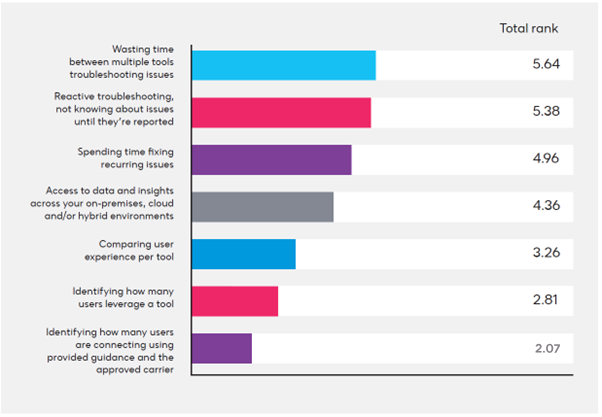In today's dynamic work environment, employees are increasingly reliant on multiple unified communications and collaboration (UC&C) tools to stay connected and productive. However, this can create a complex web of tools that must work seamlessly together, leading to frustration for employees and IT teams alike.
Challenges of working across multiple UC&C tools
IR's recent report, The IT Time Crunch, highlights the main challenges that IT teams face when working across multiple UC&C tools. These include wasting time troubleshooting issues, reactive troubleshooting, fixing recurring issues, and a lack of insight across on-premises, cloud, and/or hybrid environments.

Time wasted on troubleshooting
The biggest frustration for IT teams is the time wasted trying to troubleshoot issues across multiple tools. With so many different tools in use, it can be difficult to determine the source of the problem, leading to lost productivity.
Reactive troubleshooting can also be a problem, which could leave employees without critical tools for extended periods of time. Consider these examples:
- A salesperson is having difficulty connecting to a video conferencing call with a potential client due to technical issues. The IT team is responsible for troubleshooting the issue, but with multiple UC&C tools in use, it can be challenging to determine the source of the problem because each platform has its own troubleshooting tool and time is wasted jumping in and out of each. In the meantime, the salesperson is unable to make the call, resulting in lost productivity and potentially lost business.
- An executive is traveling for business and needs to access important files on their personal device. However, due to a lack of visibility into employee devices and applications, the IT team is unable to determine if the device is secure enough to access the files. As a result, the executive is unable to access the files they need, causing frustration and potentially delaying important business decisions.
Fixing recurring issues
Another challenge is fixing recurring issues, which can take up a significant amount of time for IT teams. This can also lead to frustration for employees who continue to face the same issues repeatedly. Consider these examples:
- An employee is having trouble with a software application that they use daily. They report the issue to the IT team, who can fix it. However, the issue continues to occur on a regular basis, causing frustration for the employee and requiring additional time and resources from the IT team to address the issue each time it arises.
- A group of employees in a particular department are experiencing slow network speeds on a regular basis, which is impacting their ability to work efficiently. The IT team addresses the issue each time it occurs but is unable to determine the root cause of the problem, leading to recurring issues and ongoing frustration for the employees.
Lack of insight across environments
A lack of insight across different environments is another major issue. With so many employees using their own devices and applications, it can be difficult for IT teams to get a clear picture of what is happening across the organization.
This can lead to confusion and wasted time, as IT teams struggle to determine the cause of recurring issues. Consider these examples:
- A group of employees are using different video conferencing tools to communicate with each other, but the IT team is unable to monitor which tools are being used and how frequently. This lack of insight can lead to confusion and inefficiencies, as different teams may be using different tools to achieve the same goal.
- An employee is experiencing connectivity issues with a cloud-based application, but the IT team is unable to determine whether the issue is with the employee's device or the application itself. This lack of insight can lead to wasted time and resources, as the IT team struggles to determine the root cause of the problem.
Solutions for overcoming UC&C challenges
Fortunately, there are solutions that IT teams can implement to address these frustrations of a complex environment. One such solution is to adopt a monitoring and performance management tool that can pinpoint the source of issues quickly, from a single point of view. This can help IT teams take steps to resolve the issues before they impact employees.
Another solution is to adopt a flexible approach that supports employees' diverse needs. This means providing employees with the necessary tools to work effectively, regardless of their location or the devices they are using.
By embracing this flexibility while using a single tool to monitor their entire ecosystem, IT teams can reduce the complexity of their technology and workflows, making it easier for employees to work across multiple UC&C tools.
Wrap up
In conclusion, the challenges of working across multiple UC&C tools can be overcome by adopting a flexible approach and implementing monitoring and performance management solutions, like IR Collaborate.
Monitoring and reporting tools, such as IR Collaborate, enable IT teams with valuable insights into the performance and usage of UC&C platforms, facilitating informed decision-making on resource allocation, capacity planning, and future upgrades.
This will enable IT teams to reduce complexity and improve productivity, allowing employees to work efficiently and effectively regardless of their location or the devices they are using.
Download our UC&C report The IT Time Crunch to learn more about how the rapidly evolving world of unified communications and collaboration is impacting IT teams in the workplace.





